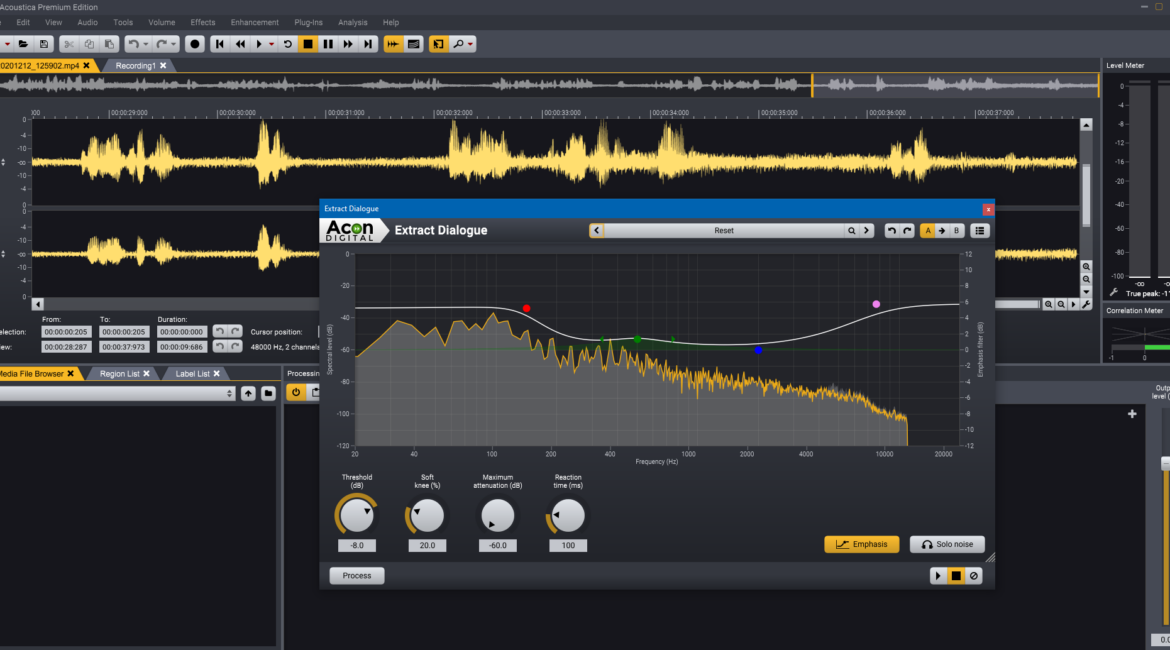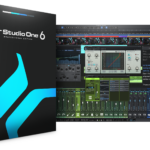by Dr David Smith
Artificial Intelligence and Neural Networking revolutionise audio noise reduction
As a documentary maker I frequently have to film people sharing their stories in situations that are less than ideal. There are numerous situations where you have no choice but to continue recording even though there is clearly audible background noise. It may have taken months to arrange for a particular person to travel to the film location and they may be reluctant to tell their story more than once. So you have just one shot at getting the story recorded, background noise and all.
Obviously it is preferable to record clean sound wherever possible, but if you have limited options you’re stuck with less than perfect audio. What can be done?
Various approaches to noise reduction have been available for many years. My primary non-linear editing (NLE) software, Vegas Pro, features a sample-based noise reduction system that’s a bit fiddly but can work very well. A similar system is seen in Sound Forge Pro. In these systems you sample a tiny portion of the noise waveform – just a couple of wave cycles is preferable – then you adjust the amount of noise reduction until you get the best result. Then you repeat this process several times until the noise is removed and you have avoided over-doing it and introducing distortions such as a ‘robotic voice’ effect. It’s a bit of an art form but it usually works well, provided you’re patient and subtle in your approach.
Accoustica 7 from Acon Digital offers several ways of removing noise, including noise analysis, Automatic De-noise and De-noise, which lets the software learn about the noise profile and then apply noise reduction dynamically. These work well and the approach you take really depends on the kind of noise you’re dealing with – once again there’s a little trial and error involved.
Experienced sound recordists seem to display an uncanny ability to hear unwanted sounds during a video shoot. This knack is crucial to their craft and reflects their many years working in a variety of settings in which background noise is an ever present component of the sound stage.
There’s an unwritten law of documentary film making which states that, no matter how remote and deserted the location, as soon as you roll the camera an aircraft will fly over and spoil the sound. My long-standing sound recordist colleague, Mark Tarpey, will always hear the distant drone of the aircraft engine long before anyone else on the set, reflecting his decades of professional audio recording for feature films and TV series.
What if you could somehow encapsulate the sound recordist’s ability to recognise unwanted sound and package that ability into an audio noise reduction plugin? That could be a game changer. Well that is precisely what Acon Digital have done in their newly released plugin called Extract:Dialogue.
As Acon Digital explain it:
Extract:Dialogue is a plug-in that separates dialogue from common types of background noise such as wind, rustle, traffic, hum, clicks and pops. The algorithm works in real time and is based on deep learning. It has been trained on thousands of high-quality voice recordings and an equally extensive set of common noise sources. The extensive training enables the artificial intelligence to automatically distinguish dialogue from noise without user interaction. This makes Extract:Dialogue extremely easy to use – just add it to your dialogue bus and let it do its magic.

Magic indeed, and from my very first test it worked, automatically and with no need for user input. As fate would have it, as I was writing this review our neighbouring parish school decided it was time for some serious lawn mowing, thereby destroying the tranquillity of our normally peaceful neighbourhood. This gave me an idea for a serious stress test of the Extract:Dialogue plugin.
Watch this video clip to see how Extract:Dialogue coped with the loud and variable noise of a tractor-based lawn mower as I spoke a commentary while walking around our back yard.
Extract:Dialogue is also available from within Accoustica 7 Premium, and although the interface is slightly more complex in this case, it is still clear and intuitive, as is the typical of all Acon Digital software. Accoustica 7.3 Prmium will come with Extract:Dialogue already included. For earlier versions of Accoustica 7 you can download Extract:Dialogue and install it using your Accoustica installation key.
Acon Digital Extract:Dialogue is available in 32 and 64 bit versions, as VST, VST3 or AAX for both Windows and MacOS or as AU plug-ins for MacOS. You may have to re-scan your VST folders from within your favorite DAW or NLE software or possible do a manual search to locate Extract:Dialogue plugin.
Downloads are available at https://acondigital.com/products/extract-dialogue/ and the full version is available for AUD$135.25
Conclusion
This is a remarkably powerful piece of Neural Network-inspired software. It has an uncanny ability to do just what its name suggests, ie to extract dialogue from a wide range of background noise scenarios. And it does this automatically for most situations. A wide range of adjustments is also possible if required and those adjustments can be saved as personal presets. Even in the extreme situation I used in the video, Extract:Dialogue was able to remove the ridiculously loud noise from a powerful lawn mower, leaving just my narration. I strongly suspect that this will become an essential part of my audio toolkit, along with my other Acon Digital favourite, Deverberate 2.
Footnote: One of Mark Tarpey’s other skills is his uncanny ability to locate cake shops in small country towns. Driving in our station wagon, loaded to the hilt with film gear, as we entered a previously unseen small countyry town in the middle of nowhere, you would invariably hear a clear message from Mark in the back seat: “profiteroles!”. And sure enough, there would be a cake shop featuring non other than these French delicacies. Ah, the joys of film trips.


